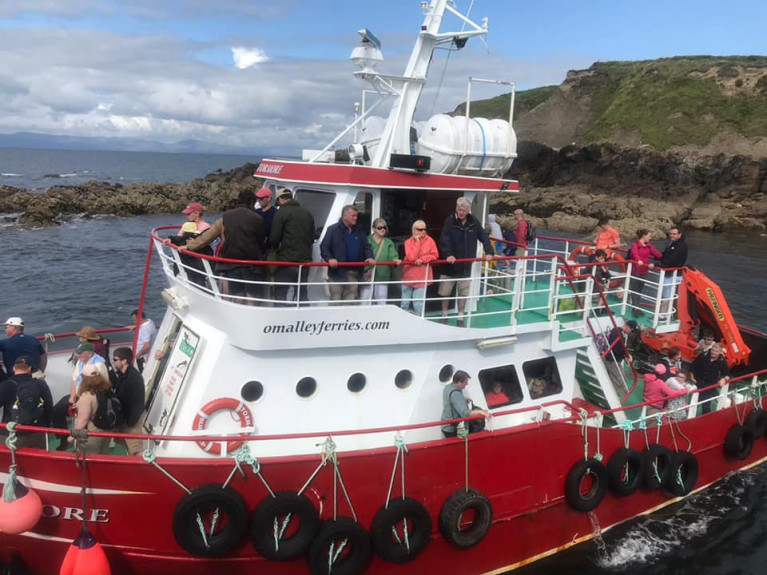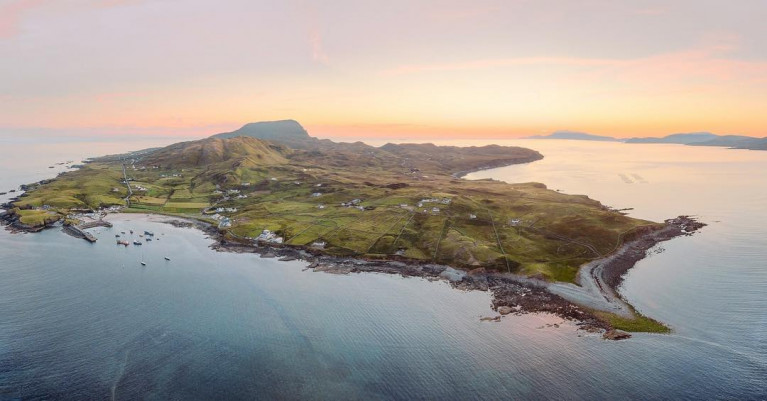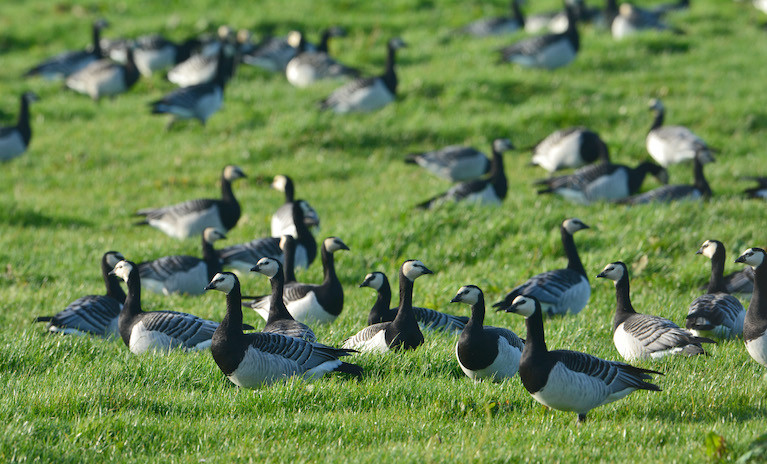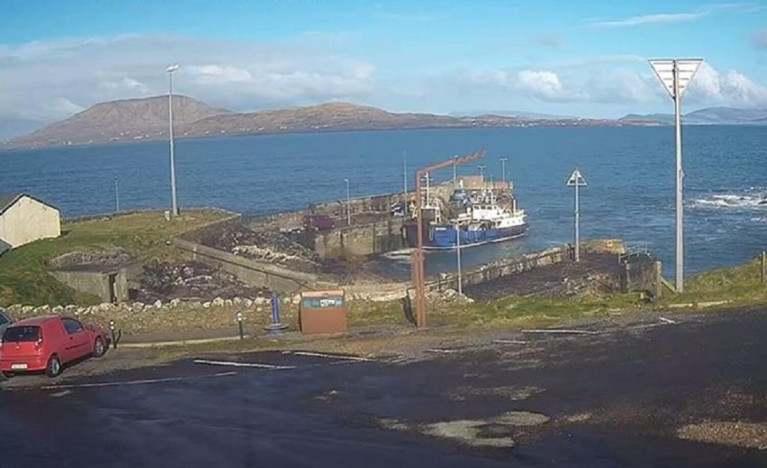Displaying items by tag: Clare Island
Achill Island Lifeboat Carries Out Medevac Off Clare Island
Achill Island RNLI carried out a medical evacuation off Clare Island on Monday night (25 March).
The volunteer crew were requested to launch the station’s all-weather lifeboat just before 9pm following a request from the Irish Coast Guard to medevac a casualty who had sustained an arm injury.
The lifeboat launched shortly after under coxswain Patrick McNamara and with six crew members onboard.
There was poor visibility at the time with the darkness of night and rain. The wind was blowing south-westerly Force 4 and there were calm to moderate seas.
Once on scene, the crew assisted the casualty onto the lifeboat where they were then safely transferred to Roonagh.
Speaking following the call-out, Michael Cattigan, Achill Island RNLI mechanic who was on the lifeboat said: “This was the first call-out of the year for the station and we were delighted to be able to help. We wish the patient a speedy recovery.
“As we approach the Easter weekend and start to enjoy the longer evenings, we also want to remind anyone planning a trip or activity at sea, to enjoy themselves but to respect the water.
“Always wear a lifejacket or suitable flotation device and always carry a means of calling for help. If going out on a boat, check your engine in advance and make sure you have enough fuel for your trip.
“Always check the weather and tide times before venturing out and make sure someone on the shore knows where you are going and when you are due back. Should you get into difficulty or see someone else in trouble, call 999 or 112 and ask for the coastguard.”
Sailors visiting Mayo’s Clare Island have been reminded that the public water supply is subject to restrictions due to cryptosporidium contamination.
Uisce Éireann says the cryptosporidium issue was detected in June, and a boil water notice issued then “remains in place on the public water supply” for the island in outer Clew Bay.
“Operational and compliance experts from Uisce Éireann and Mayo County Council continue to work to lift the notice as quickly and safely as possible,” it says.
The boil water notice affects about 160 island residents, along with a large number of summer visitors, including sailors.
Uisce Éireann’s Colette Scahill thanked the local community for their cooperation and assured them that a team is working to lift the notice.
“Please be assured that we are working to lift the notice as quickly and safely as possible,” Scahill said.
“ Monitoring of the supply will continue for the month of September, and plans to increase the robustness of the water treatment plant are in progress. The notice will be reviewed again with the HSE at the end of September,” she said.
Water must be boiled for:
- drinking;
- drinks made with water;
- preparation of salads and similar foods, which are not cooked prior to eating;
- brushing of teeth;
- ice making - discard ice cubes in fridges and freezers and filtered water in fridges, and make ice from cooled boiled water.
Mayo’s Clare island has been hit with a “boil water” notice after the detection of cryptosporidium in the public water supply.
The “boil water” notice takes immediate effect, Uisce Éireann (Irish Water) and Mayo Council have said.
This follows consultation with the Health Service Executive (HSE) to protect the health of approximately 160 people on the island’s public water supply scheme.
The two bodies have said they are “working to implement solutions to lift the notice as quickly and as safely as possible in consultation with the HSE”.
Uisce Éireann’s Ger Greally acknowledged the impact of this notice on the community and expressed regret at the inconvenience to those impacted.
Uisce Éireann said that vulnerable customers who have registered with it will receive direct communication on the “boil water” notice, and are reminded that the water is safe to consume once boiled and cooled.
Water must be boiled for:
- Drinking;
- Drinks made with water;
- Preparation of salads and similar foods, which are not cooked prior to eating;
- Brushing of teeth;
- Making of ice - discard ice cubes in fridges and freezers and filtered water in fridges. Make ice from cooled boiled water.
A map of the affected area is available to view on the supply and service section of water.ie.
‘Banshees of Inisherin’ Views Among Charms of Clare Island Lighthouse Now on the Market for €4.8m
Clare Island’s lighthouse is a “distinctive nautical landmark” on Ireland’s West Coast and it could be yours — for €4.8 million.
Highlighting its scenic views to the land of Oscar-nominated film The Banshees of Inisherin, Christie’s International Real Estate touts the restored waterfront property’s residential and guesthouse opportunities in its private and secure location.
One of the ‘Great Lighthouses of Ireland’, Clare Island Lighthouse dates from 1806 when it was built by Marquis of Sligo and was one of the 13 Irish lights taken over by the Ballast Board in 1810.
The original lighthouse was destroyed by fire in 1816 and a second tower was built two years later, remaining in service until the lighthouse was decommissioned in September 1965.
Since then it has been restored as luxury accommodation comprising the original lighthouse towers, a number of small cottages and converted outbuildings, with walled gardens with a helipad on nearly a hectare of grounds.
Clare Islanders Advised to Boil Water With "Immediate Effect"
Irish Water has issued a “boil water” notice with “immediate effect” for residents on Mayo’s Clare Island.
Difficulties with the disinfectant procedure at the Clare Island water treatment plan are said to be the reason for the measure, which relates to about 165 islanders using the public water supply.
“Irish Water’s drinking water compliance and operational experts are working with colleagues in Mayo County Council to resolve the situation with a view to having the notice lifted as quickly as possible,” the agency said.
“In the meantime, all customers of this supply are advised to boil water before use until further notice,” it said.
Irish Water’s asset operations lead Ger Greally acknowledged the impact the measure will have on the community and apologised for the inconvenience to customers.
“We will continue to work closely with Mayo County Council and the HSE to monitor the supply and lift the notice as quickly as it is safe to do so and safeguard the supply for the future,” he said.
The notice will only be lifted once the issue is resolved and in consultation with the Health Service Executive.
Irish Water said that vulnerable customers who have registered with it receive direct communication on the “boil water” notice, and are reminded that the water is safe to consume once boiled.
“Those who have concerns should contact our customer care team on 1800 278 278,” Irish Water said.
Customers can also check by visiting www.water.ie/help/water-quality/ and entering their property’s Eircode in the search bar, it said.
Irish Water advised that water must be boiled for:
- Drinking
- Drinks made with water
- Preparation of salads and similar foods, which are not cooked prior to eating
- Brushing of teeth
- Making of ice - discard ice cubes in fridges and freezers and filtered water in fridges. Make ice from cooled boiled water.
Achill Island RNLI was involved in the medical evacuation of a patient from Clare Island at the weekend.
The volunteer lifeboat crew launched at 9.29 am on Saturday (14 August) under Coxswain Dave Curtis and with five crew members on board. It followed a request from the Irish Coast Guard to assist with the evacuation of a patient from the island. Sea conditions were flat calm at the time and the weather was overcast with some drizzle.
The all-weather lifeboat Sam and Ada Moody arrived at Clare Island at 9.51 am. Four crew members proceeded to go ashore and prepare a safe landing site for the Irish Coast Guard helicopter Rescue 118 from Sligo which was also tasked to the scene. The lifeboat crew then assisted the island nurse and the crew of Rescue 118 with transferring the patient to the aircraft before they were airlifted to the hospital.
Speaking after the call out, Achill Island RNLI Coxswain Dave Curtis: ‘We were happy to help and would like to wish the casualty well. We train regularly for situations like this and this call out was a good example of a good inter-agency response from our own volunteers here in Achill and our colleagues in the Irish Coast Guard.’
An official confirmation of a new five-year contract for the provision of a subsidised ferry service to Clare Island off Co. Mayo has been welcomed by Deputy Michael Ring.
The €1 million contract has been agreed between the Department of Rural and Community Development and O’Malley Ferries (Clare Island) Ltd. and will provide for four daily return sailings from Clare Island to Roonagh pier on the mainland.
In addition to the core service, the operator will also provide an additional extra weekly ‘fast ferry’ sailing that will be scheduled at the island community’s discretion.
The contract came into effect (yesterday) and the contract cost is estimated to be €1,020,000 over the next five years.
The Connaught Telegraph has more.
Increased Sailings Confirmed for Clare Island Ferry Service
Deputy Alan Dillon, Fine Gael Spokesperson on Tourism & Sport, welcomed confirmation from Rural & Community Development Minister, Heather Humphreys TD, that her Department will be increasing daily ferry sailings to Clare Island.
A tender recently issued by her Department only required a minimum of two return services daily. This meant that something as simple as a medical appointment might require an islander having to sacrifice an entire day to travel to the mainland.
The ferry service will now be increased to four return sailings daily, which should prove a real game changer for people living on the island. In addition to increasing tourism opportunities.
More here reports Mayo Advertiser that follows a campaign by islanders to improve the service
Are Unexpected Changes in Bird Species Migration to Clare Island a Result of Global Warming?
110 years ago Robert Lloyd Praeger brought a group of eminent European scientists to Clare Island to map the flora, fauna, geology and archaeology of the small, exposed Atlantic island off the coast of Mayo. The Royal Irish Academy’s New Survey of Clare Island, a unique multidisciplinary endeavour that together with Praeger’s first Clare Island Survey provides an invaluable body of research informing future conservation of the natural and built heritage of Ireland and Europe.
In a new book, New Survey of Clare Island. Volume 9: Birds, published on Monday, 17 August to celebrate Heritage Week 2020, the editor Tom Kelly traces the story of the birds from Clare Island.
One of the most dramatic changes has been the arrival on Clare Island of the formidable and spectacular seabird the Great Skua—or Bonxie—which now breeds further south in Ireland than it does in Great Britain. This unexpected change—a species moving south rather than vice versa—at a time of global warming remains to be explained.
 A Great Skua Photo: Richard T. Mills
A Great Skua Photo: Richard T. Mills
Clare Island became separated from Ireland about 8,000 years ago by rising sea levels brought about by the melting of the massive ice sheets that formed during the last Ice Age. Although this dramatic event would have had a minimal impact on the birds that made the island their home.
The Lapland bunting and the snow bunting probably arrived first, followed by more sedentary species including the rock ptarmigan and gyrfalcon as well as many wildfowl and wading bird species.
In the three millennia that followed the formation of Clare Island, mature woodland developed allowing a woodland bird community to develop.
 The Clare Island survey
The Clare Island survey
Neolithic man arrived about 4,000yBP (years Before Present). Over the succeeding 3,500 years or so, the woodland element was gradually removed and about 400 years ago the modern agricultural landscape was established. The woodland bird community on Clare Island has become mostly extinct probably because its habitat gradually disappeared over the millennia, In addition, the famines of the early to mid-nineteenth century had an impact on the ecology of the inhabited offshore islands. The abandonment of land as a result of famine, and the peoples who occupied that land, is well known to cause the departure of synanthropic bird species.
Nevertheless, agricultural activity and the expansion of grasslands created opportunities for seed-eating species and ground-nesting forms such as the skylark and meadow pipit and migrants such as the northern wheatear and corncrake, and the extraction of peat created opportunities for wetland species. Well-known species such as the house sparrow, European robin, song thrush and perhaps the barn swallow have colonised the island.
Roonagh Pier is Part of €525,000 Investment in Co. Mayo
An investment of €525,000 is to be put into four piers and harbours in Co. Mayo.
The Minister for Agriculture, Food and the Marine, Michael Creed announced details of a €3.1m package to assist 10 coastal local authorities undertake and as Afloat previously reported funding to complete 58 developments of harbours repair projects and slipways owned by them.
The package, reports Connaught Telegraph, provides funding for maintenance and repair works in addition to supporting the ongoing development and enhancement of harbour facilities including some marine leisure developments.
The Mayo works announced include Roonagh Pier as Afloat also reported on where provision of a new crane and safety improvement works is to cost €150,000.
For other coastal development works and locations click here.






























































